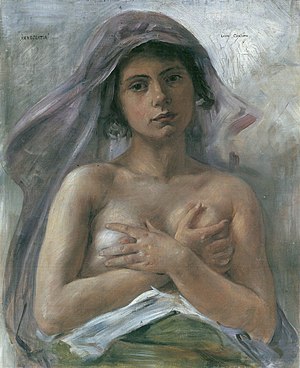Innocentia (Lovis Corinth)

|
| Innocentia |
|---|
| Lovis Corinth , 1890 |
| Oil on canvas |
| 66.5 × 54.5 cm |
| Municipal gallery in the Lenbachhaus |
Innocentia (Innocence) is a painting by the German painter Lovis Corinth from 1890. The picture shows a female half-nude and is currently owned by the Städtische Galerie im Lenbachhaus .
Image description
In the catalog raisonné of Corinth's paintings, the picture is described as a half-nude with a violet veil. It shows a young girl with a bared upper body in a frontal view, who crosses her arms in front of her chest and thus partially covers her breasts with her hands . The belly below the arms is covered by a white and olive-green garment (a striped white-lined olive-green dress). The right nipple can be seen between the middle and index finger of the left hand .
On her head, which is held at a slight angle, she wears a purple cloth that hangs down as a veil behind her right shoulder and thus forms the background to the body. The look seems melancholy and absent-mindedly dreamy.
The background is white and off-white. The picture is inscribed with the title innocentia in the upper left image field without the year and signed Lovis Corinth in the upper right image field .
interpretation
According to Andrea Bärnreuther 1996, the grip of the hands represents a gesture of self-perception of the physicality as a woman. She sees this as a translation of the gesture of humility known from depictions of Mary and Magdalene into the language of naturalism and gives it motivation as an expression of the psycho-physical self . “Andreas Dehmer 2008 also compares the picture with religious depictions of a vestal virgin , Mary or the penitent Maria Magdalena, referring to the title of the picture suggesting chastity and innocence.

|

|
|
|
left: Raffael : “La Fornarina”, 1518–1519, right: Cornelis van Haarlem : “Monk and Beguines”, 1591
|
||
In his opinion, however, “Innocentia” is “only superficially an embodiment of innocence”. He refers to the contradiction in the representation through the consciously exposed nipple. As a result, the picture is reminiscent of paintings by courtesans such as Raphael's “Fornarina” from 1520 and he refers to the image of the “saint and whore”. Dehmer puts forward the thesis that corresponding depictions from the Dutch Baroque Corinth could have served as a model, in which a nun is pressed a nipple to stimulate the flow of milk to check the suspicion of pregnancy. Specifically, he names the picture “Monk and Beguines” by the Dutch painter Cornelis van Haarlem , which Corinth may have inspired in the Haarlem Museum and whose iconography may have been taken up by him.
Andrea Bärnreuther refers to “the incarnation literally brought before one's eyes”, “which plays with the transitory of the erotic in the dialectic of concealment and exposure” and Dehmer also points to this interplay that the “Donna velata” (“veiled Woman ”) is reinforced.
Creation, exhibitions and provenance
Few facts are known about the creation of the picture. In the works of Charlotte Berend-Corinth image first appears in the revised 2nd edition in the addendum (BC 988) on while it is missing in the first edition.
The picture was in private ownership until it was acquired by the Städtische Galerie im Lenbachhaus . It was first exhibited here in 1975. The Folkwang Museum in Essen and the Kunsthaus of the Hypo-Kulturstiftung in Munich showed the picture in 1985/86. The picture was exhibited in the Kunstforum Wien in 1992 and in the Lower Saxony State Museum in Hanover in 1992/1993. Further exhibitions took place in 1996 in the Alte Nationalgalerie in Berlin and in 2008 in the retrospective for the artist's 150th birthday, which took place in the Musée d'Orsay (Paris), the Museum of Fine Arts (Leipzig) and the Art Forum Ostdeutsche Galerie (Regensburg).
supporting documents
- ↑ a b c d Charlotte Berend-Corinth : Lovis Corinth: The paintings . Revised by Béatrice Hernad. Bruckmann Verlag, Munich 1992; BC 988, p. 209. ISBN 3-7654-2566-4 .
- ↑ a b c d Andrea Bärnreuther: Innocentia, 1890. In: Peter-Klaus Schuster , Christoph Vitali, Barbara Butts (ed.): Lovis Corinth . Prestel Munich 1996; 189. ISBN 3-7913-1645-1 .
- ↑ a b c Andreas Dehmer: Innocentia, around 1890. In: Ulrike Lorenz , Marie-Amélie zu Salm-Salm, Hans-Werner Schmiedt (ed.): Lovis Corinth and the birth of modernity . Kerber Verlag Bielefeld 2008; Pp. 258-259. ISBN 978-3-86678-177-1 .
literature
- Charlotte Berend-Corinth : Lovis Corinth: The paintings . Revised by Béatrice Hernad. Bruckmann Verlag, Munich 1992; BC 988, p. 209. ISBN 3-7654-2566-4 .
- Andreas Dehmer: Innocentia, around 1890. In: Ulrike Lorenz , Marie-Amélie zu Salm-Salm, Hans-Werner Schmiedt (eds.): Lovis Corinth and the birth of modernity . Kerber Verlag Bielefeld 2008; Pp. 258-259. ISBN 978-3-86678-177-1 .
- Andrea Bärnreuther: Innocentia, 1890. In: Peter-Klaus Schuster , Christoph Vitali, Barbara Butts (eds.): Lovis Corinth . Prestel Munich 1996; 189. ISBN 3-7913-1645-1 .